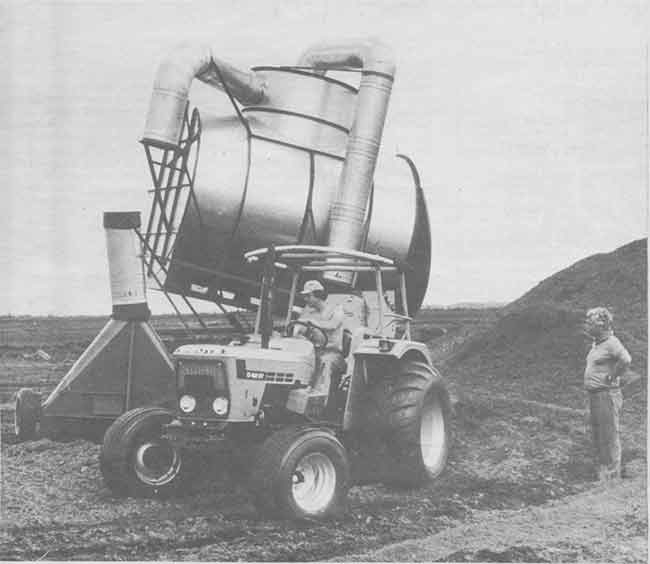
News
INDUSTRY VIEW: Looking back on our first 35 Years
Skimming through the early editions was inspirational. There are so many familiar names from those early days, people who helped shape the industry into what it has become, and who are still involved in its growth today.
November 13, 2015 By Dave Harrison
 SEPTEMBER 1982 ISSUE: Then publisher/editor Jim Brown toured the ASB facilities in Pointe Sapin, New Brunswick.
SEPTEMBER 1982 ISSUE: Then publisher/editor Jim Brown toured the ASB facilities in Pointe Sapin, New Brunswick. The industry has certainly changed a lot over the past 35 years, and Greenhouse Canada has been a keen observer of the transformation.
We’re just completing 35 years of industry coverage, and are taking the opportunity to browse through past issues to sample some of the highlights of what we’ve published.
This is a quick and cursory overview of the magazine and some of the events and trends it has reported on throughout 35 years.
THE DEBUT
Growth Publications distributed 1,600 copies of its first edition. “To be honest,” publisher/editor Jim Brown noted, “we were scared. We really didn’t know what the reaction would be.”
The main objective was simple. “Each month, we want growers to count on Greenhouse Canada to deliver the news on all the important factors affecting their industry.”
One of the main issues back then, interestingly enough, was “the high cost of energy.”
Stories that debut issue included a recap of the Canadian Greenhouse Conference (60 booths, and 1,000 registrations the first day alone), a joint venture by Flowers Canada and the Canadian Ornamental Plant Foundation to promote poinsettia sales, a profile of how a retail grower was dealing with chain store competition, and a biomass heating feature. There was also a story noting continuing concerns in the U.S. with the rising number of cut flower imports.
Within several months – by July 1981 – circulation had increased 50 per cent to the 2,400-mark, followed by another 400 subscribers who signed up at the Canadian Greenhouse Conference that year! The magazine was clearly on a roll. An industry need was being addressed, one feature, one page and one issue at a time!
The editorial in the January 1981 edition called upon governments to develop “buy local” programs for greenhouse vegetables. The vegetable side of the industry, it appears, was facing some challenges, especially with field imports. The issue was even debated in the Ontario Legislature. Lorne Henderson, the province’s ag minister, was sympathetic to the growers’ plight, but noted energy costs were a major factor in those challenging times.
“The House should be aware that the normal acre of greenhouse produces about $75,000 worth of products a year. If they continue producing through this period, it costs them about half that for energy alone.”
Dr. Theo Blom, a greenhouse floriculture extension specialist with the Ontario Ministry of Agriculture and Food, had a feature in this issue on the challenges facing the Dutch industry. “Computers have become commonplace in many Dutch greenhouse operations,” he noted in this report.
The October 1981 edition marked the first preview coverage of the CGC by the magazine, an 11-page section that listed the exhibitors and outlined the educational sessions.
Also making its debut in 1981 was the magazine’s annual Buyers’ Guide, a one-stop directory of companies, products and services that has continued to the present.
1982 – As noted earlier, energy was a significant challenge in the early 1980s. The February issue highlighted “An Energy Management Strategy for Ontario Greenhouses,” drafted by the Ontario Ministry of Agriculture and Food. Part of the report encouraged growers to switch from oil to natural gas or other energy sources.
And what would a magazine be without an opinionated editor. The May editorial focused on the Ontario government’s decision to re-introduce a tax on plants. “This plant sales tax is just another example of a feeble bureaucratic attempt to balance the blatant overspending which has gone on in this country despite the recession.”
1983 – The February cover story looked at a demonstration greenhouse project that was drawing waste heat from the Bruce Nuclear Power Development station in Ontario.
With this issue, the magazine had converted from a tabloid newspaper format to the more familiar magazine size, with glossy cover pages and newsprint pages.
1984 – The May edition included a story on liquid CO2 supplementation. It was included in a grower profile on B.C. vegetable grower Tony Kavelaars in the Fraser Valley. With CO2 application, yields were up 15 per cent, the incidence of disease was reduced, and the capital investment then was said to be about $1,500.
Brian Mauza, a greenhouse specialist with B.C. Ministry of Ag and Food, reported on the B.C. greenhouse veg industry. In 1984, it comprised 110 growers and 85 acres of greenhouse space, including 47 acres of tomatoes, 24 acres of cucumbers, and nine acres of lettuce. The average operation was about 30,000 square feet. The main growing region was then in the Fraser River Valley.
1985 – The January issue featured a report on biocontrols with cucumbers and tomatoes, written by R.A. Costello, an entomologist with the B.C. Ministry of Ag and Food, and Don Elliot of Applied Bio-nomics.
While there had been reports of import pressures in earlier editions, the year’s May issue included a commentary about the impending challenge from South American carnation and rose producers to domestic growers. “Modern jet transportation and improved post-harvest handling techniques have made it possible for southern developing nations, in search of hard currencies, to deliver a high quality, fresh carnation or rose into almost any major U.S. or Canadian city, and do so more cheaply than a domestic producer is capable of during much of the year.”
The August 1985 edition reprinted “Development of the Harrow peat bag,” an article Dr. Tom Papadopoulos of the Harrow Research Station of AgCanada, presented at the International Symposium on Plant Substrates and Growing Techniques, held at the University of Norway.
In his report, Papadopoulos noted Canada was then home to 200 hectares of greenhouse tomatoes and vegetables, in addition to a smaller total area devoted to other vegetables. Leamington then had about 100 hectares in production, making it the “largest concentration of greenhouse vegetables in North America.” The Niagara region had about 20 hectares of greenhouse vegetables at this time.
October marked the debut of fully glossy stock paper throughout the magazine. (It had featured a glossy cover with newsprint pages for a few years.)
1986 – A report on the first-ever full scale Exposition commercial de l’horticulture ornamentale was presented in the January issue. The three-day show was held the previous November in Saint-Hyacinthe. The show featured 150 exhibitors.
The March edition featured a mini history of the United Flower Growers and its hosting of the first Dutch-style flower and plant auction in Canada. UFG was founded in 1986 by six local producers.
The August and September issues this year included a two-part feature on alstroemeria as a new cut flower crop, written by John Hughes, Jim Tsujita, Theo Blom and Wayne Brown. “Presently, commercial greenhouse production in Canada has been limited to a few growers in British Columbia and Ontario.”
The June issue reported the sale of Greenhouse Canada to Cash Crop Farming Publications, based in Delhi, Ontario. (Coincidentally, I was working with the company’s newspaper division at this time.)
“Cash Crop Farming is a mature publishing company with extensive experience in the production of business management journals. Greenhouse Canada will be in good company,” said publisher
and editor Jim Brown. “Cash Crop Farming publishes a number of agri-business magazines, including Ontario Corn Producer and Canadian Fruitgrower (and Canadian Tobacco Grower). Rest assured these guys know what crop production and marketing is all about.”
July, then, marked the first issue for the magazine under Cash Crop Publications. The new management team included publisher Ted Crandon, manager and advertising manager Bart Crandon, editor-in-chief David MacLaren and editor Ben Steidman.
“Buying Greenhouse Canada was such a good fit for our company,” Bart Crandon recalls. “We had other agriculture magazines that did well, and we knew Greenhouse Canada could be just as successful for us.”
They talked to some greenhouse growers in the Delhi area and were reassured the magazine would have a strong future in the industry.
“Agriculture was the backbone of our company and we saw the potential of the greenhouse industry. We really went to work on it and it was a great success from the get-go. We couldn’t have been happier with it.”
He noted that his brother Mark, who took over as advertising manager a little while later, “took the magazine to the next level.”
The main feature was a grower profile of Ben Veldhuis Ltd., a 69,000-sq.ft cactus operation in Dundas, Ontario. Another feature looked at the work of Luc Desrochers of Bioserre in Quebec, who was using floating raft technology to grow lettuce. A third feature profiled rose research by Dr. Mike Dixon at the University of Guelph.
1988 – A January feature noted the Canadian ornamental sector generates some $300-million in sales annually, with exports accounting for $40 million. This was part of a presentation by Flowers Canada at a meeting convened by the Canadian Horticultural Council with a variety of federal ministries. Flowers Canada stressed a number of points, including the importance of research funding and passage of the free trade deal, along with the need for a level North American playing field with pesticides.
The June cover story was headlined: “Peppers – the next greenhouse vegetable.” It was estimated that about 10,000 square feet of pepper production had been carried out in the Leamington area in 1987. In 1988, some five acres were being cultivated.
1989 – The appointment of Mark Crandon as the new advertising manager was announced in October. Bart Crandon had been promoted to general manager. Mark had previously sold newspaper and trade magazine advertising for 10 years.
This was also the month Melhem Sawaya was officially welcomed as a new regular columnist as author of “Growing In The Green.” He’s been a steady contributor since that date.
1990 – A conveyor lift mechanism won the top prize in 1990 in the first-ever Growing Ideas Contest sponsored by the Canadian Greenhouse Conference. It was submitted by Spring Valley Gardens of St. Catharines.
1991 – The January editorial voiced concern over a GST proposal to tax flowers, while other farm products were exempt.
The March editorial put the size of the Niagara flower industry into perspective when it said total space would be equivalent to a single greenhouse one kilometre long and 600 metres wide. Floral exports that year from the region were projected at $10 million. Niagara was home to about half the flower production in the province.
An Ag Canada report in September noted the significant market potential of ethnic vegetables due to Canada’s multicultural diversity. The Vineland Research and Innovation Centre is currently involved with such research.
1992 – A February issue report on Alberta noted the province had 122,000 square metres of cucumbers and 50,000 square metres of tomatoes. In other regions, tomatoes are the dominant crop.
October saw the first of a series of Cecil Delworth Foundation “Bulletins” highlighting the latest research and crop culture information. The first feature was written by Wayne Brown on the subject of bract edge burn on poinsettias.
1993 – The February issue featured our first coverage by a freelancer of the Alberta Horticultural Congress, held in Edmonton. In addition to educational sessions, the Congress included a tour of Garden Valley Greenhouses and Morinville Greenhouses.
A June feature highlighted the silver anniversary celebration of the Ontario Greenhouse Vegetable Producers’ Marketing Board, which published a “25th Anniversary Collection” cookbook to mark the occasion.
1994 – The September issue had a story promoting the “Evening of Appreciation” planned for Dr. Jim Tsujita of the University of Guelph. In addition to his teaching and research career, he had served as president of the Canadian Society of Horticultural Science and the Canadian Ornamental Plant Foundation. He was also honoured for his research efforts by Flowers Canada and Roses Inc. A full feature on his career was published in the October edition.
The November edition noted the retirement of Dr. Bill Jarvis from the Harrow Research Station. He was presented with a plaque for his service to the industry by Denton Hoffman, general manager of the Ontario Greenhouse Vegetable Producers’ Marketing Board. The presentation was made during the Canadian Greenhouse Conference.
1995 – The April edition promoted the magazine’s first annual Grower Day (to be held in June). The first Grower Day focused on poinsettias and attracted 200 growers. Grower Day has been held annually since then, except for one year due to scheduling problems.
Blair Adams was welcomed as the new editor in May. His first editorial reviewed the impact of a 19 per cent budget cut announced by AgCanada, and what it would mean to the greenhouse sector.
The October edition featured a report on “The Quest for a Reliable Workforce.” It was prepared by Ontario’s horticulture industry, and stressed the importance of offshore labour in meeting the sector’s
labour requirements as well as the economic benefits these workers offer provincial and municipal economies. “Currently, the industry is not working at 100 per cent of its capacity or efficiency,” noted the report authors.
1996 – The March edition welcomed a new editor at the helm – me. (Blair Adams had moved on to edit a few other magazines with the company.) In the editorial photo, I don’t have a single grey hair … my, how things have changed over the years. It’s a coin toss whether editing the magazine or raising a pair of teenage girls prompted the change in hair colour!
The May edition featured coverage of my very first industry conference – the spring meeting of Roses Inc. held in Niagara-on-the-Lake. It was billed as “The Days of Wine and Roses” convention. Growers came from as far away as California, Mexico, Alberta and Colorado.
In a June feature on the Leamington region, we noted the combined farmgate value of greenhouse tomatoes and cucumbers there had grown from about $65 million in 1993 to $100 million in 1996.
1997 – That year’s February issue had a feature on a blizzard described by meteorologists as a “75-year storm” that hit much of British Columbia between Christmas and New Year’s Day of 1996. Damage estimates on the ornamental side were $8 million in structural losses and $4.5-million in crop losses.
Also in that February issue was our preview of the first annual Canada Blooms event, which was being held at the Toronto Congress Centre that March. There were 40 show gardens planned, along with an extensive speaker program.
The March issue featured the debut of “Grower Notes,” a regular feature from Ontario Ministry of Agriculture, Food and Rural Affairs specialists.
1998 – The February issue had a U.S. report that noted the shifting of market shares by various flower sectors. Cut flowers, which represented 50.5 per cent in 1970, had dropped to 14.6 per cent in 1996, while bedding plants increased from 13.5 per cent in 1970 to 46.3 per cent in 1996.
The February edition also featured a report on a major ice storm the previous month in eastern Ontario, Quebec and parts of New Brunswick. One Quebec grower we talked to lost two of his five greenhouses to the storm. Another grower reported an ice buildup of 40 centimetres on his greenhouse roof.
1999 – “The potential (and the challenges) of greenhouse raspberries,” was among August features. Research in both Ontario and Cornell said the berry had potential as a greenhouse crop, though they are “risky and expensive” to grow, according to a Belgian specialist attending an Ontario conference.
The September issue featured a story on the new food safety program launched by the Ontario Greenhouse Vegetable Growers and led by food safety specialist Dr. Doug Powell of the University of Guelph.
2000 – January had a feature on a major investment project with the Agassiz facilities of the Pacific Agri-Food Research Centre. Included would be new greenhouses.
A March story noted the Alberta greenhouse industry included 400 growers and 212 acres. The value of production was estimated to be $75 million.
The April edition featured stories from our first study tour of the Netherlands. The tour was hosted by the International Flower Bulb Centre.
2001 – The January issue noted the CGC was moving from University of Guelph to the International Centre in Toronto for the 2001 conference. “We had outgrown the University of Guelph, and I think the university felt the same way,” said CGC executive committee chair Cliff Janitsch. “There was really no other choice.”
March featured a tribute to Peter Heywood, the long-time editor/publisher of Canadian Florist, Greenhouse and Nursery. He had passed away earlier in the year. Mr. Heywood had been involved in a number of associations, including the Cecil Delworth Foundation, and worked tirelessly to promote the CGC during its formative years.
2002 – The average greenhouse vegetable operation in Ontario was 4.3 acres in 2002, according to a report in our June issue. Leading crops were tomatoes (728 acres), cucumbers (326), and peppers (224).
The August edition had our report on the 2002 Floriade show in the Netherlands, including a tour of the Greenhouse Of The Future complex.
The October edition featured our report on the latest in bulb cultivation in the Netherlands. We had toured several bulb greenhouses on a study tour earlier in the year. Hydroponic bulb cut flower production was increasingly popular among growers.
2003 – September had a feature on CanAgro Produce of Delta, B.C., thought to be the first grower in North America to utilize landfill gases for a cogen system.
The Ontario Greenhouse Alliance was formed in 2003, a strategic partnership of flower and vegetable associations in the province.
Our May edition featured stories on my study tour (November 2002) of the Bogota cut flower region. Among innovations that impressed us were the use of tobacco plants as sticky traps by one grower (the leaves are quite gummy), the transportation infrastructure for cut flower exports, the extensive water conservation measures that had been developed, and the many assistance programs available to enhance the quality of life for employees.
2004 – A major energy workshop was hosted in Niagara Falls by Environment Canada, the Consulate General of the Netherlands, the Regional Municipality of Niagara, and the Niagara
Economic and Tourism Corporation. Topics included wind turbines, cogen, energy efficiency improvement to existing boilers, thermal energy storage, and biomass heating systems.
A mid-February blockbuster blizzard caused an estimated $2 million in damage to Nova Scotia’s greenhouse industry. The storm dumped up to 95 centimetres of snow in a very short timeframe.
2005 – Our February issue had a tribute to industry icon Lois Hole, who had passed away in early January of that year. As we wrote at that time: “As a horticulturist and humanitarian, Lois Hole had few peers in either role.”
December featured a report of the visit of Mexican president Vincente Fox and his wife, First Lady Marta Sahagun de Fox to Houweling’s Nurseries in Delta, B.C. The president was impressed by Canada’s foreign worker program and wanted to visit a greenhouse during his visit to Canada.
2006 – Stokes Seeds celebrated its 125th anniversary in 2003, and we featured them in a March cover story.
An April feature reported on the recently released TOGA study that found the Ontario greenhouse industry generates almost $4 billion to the economy. The industry was found to have an economic multiplier of 2.81 – for every dollar of greenhouse activity, the economy as a whole experiences output impacts of $2.81. The farmgate value was pegged at $1.1 billion.
2007 – July featured our new redesign, and we welcomed new columnist Gary Jones of Kwantlen University in that edition.
In September, an Ontario greenhouse vegetable report (total acreage of 1,673) found the following crop mix: tomatoes, 47.5 per cent; peppers, 30; and cucumbers, 22.6.
2008 – The March edition previewed the International Garden Centre Association Congress being held in September. It was hosted by the B.C. Landscape and Nursery Association, along with the Canadian Nursery Landscape Association.
In October, we voiced our concerns with the free trade deal with Colombia. Not only did Canada fully open the domestic market to cut flower imports, there was no help offered to growers to help them make the transition to other crops. There was no phase-in of the tariff cuts.
2009 – May included a feature on Symbiosis, the marketing program of a group of Quebec organic growers.
In August, we published a nine-page special section on the centennial celebration of the Harrow Research Station (Greenhouse and Processing Crops Research Centre). The articles were supplied by the researchers and extension specialists.
October included our report of our third study tour to the Netherlands. The focus was on new technologies and marketing programs.
2010 – The March 2010 issue had a feature of excerpts from “The Winter Harvest Handbook: Year-Round Vegetable Production Using Deep Organic Techniques and Unheated Greenhouses. It was written by Eliot Coleman, a grower with considerable experience with low-tech greenhouse technology. We single this feature out because it has become one of our most popular website stories of all time.
August included an update on cleanup efforts following the tornado that hit Leamington on June 6. It devastated several greenhouse operations, in particular the Yoder Canada facilities.
2011 – Our January story noted the CGC had decided to move to Niagara Falls beginning with the 2011 show. It had been held at the International Centre in Toronto since 2001. Before that, it had been at the University of Guelph since 1979.
November included a feature on Lufa Farms in Montreal, the world’s first commercial rooftop greenhouse operation.
2012 – Our first issue of the year included a recap of the CGC’s first year at the Scotiabank Convention Centre in Niagara Falls. It was a successful transition all round, with the highest attendance in many years and a hearty “two thumbs up” from the exhibitors. Attendance topped the 2,275 mark.
April included results from our first annual grower survey. It’s more an industry “snapshot in time” than a survey, but we’re hoping to establish some baseline stats growers can relate to. The next survey will be available in January, with the results published next May.
2013 – The January issue featured our coverage of the fall of 2012 conference of the Association of Education and Research Greenhouse Curators, held at the University of Toronto. Delegates toured the Niagara region, including the new Brock University greenhouses, along with Priva, Vineland and Niagara College.
The March/April edition featured an introduction to the robotics program at Vineland Research and Innovation Centre, emphasizing its collaborative approach in working with commercial growers in trialing the prototypes being developed.
2014 – January featured our story on the second Lufa Farms rooftop greenhouse to be opened in Montreal, this one in the borough of Ahuntsic-Cartierville. Much of the technology in the new 43,000 square feet greenhouse is proprietary, including its irrigation and cropping systems.
November included our introduction of our first Top 10 Under 40 award winners. The winners had formally been announced during the CGC the previous month.
Dr. Mohyuddin Mirza was named to the Alberta Agriculture Hall of Fame, the latest in a long list of accolades for the greenhouse crops specialist. We have been fortunate the past few years to work with Dr. Mirza in publishing regular crop features – including within this issue – for both flowers and vegetable growers.
2015 – Our inaugural State of the Industry report was the January cover story. Topics raised included the “Buy Local” movement, the growth of sales to the food service sector, and new technologies.
February marked the launch of our completely redesigned magazine, which included expanded New Varieties coverage, and monthly Business Issues and Technology Issues features, among other changes.
One of our March/April features looked at the growing sales and marketing opportunities available via onsite or community farmers’ markets.
The year also included our second annual Top 10 Under 40 award winners (November), and extended features on alternative heating sources (August) and LED lighting research (October).
Print this page










